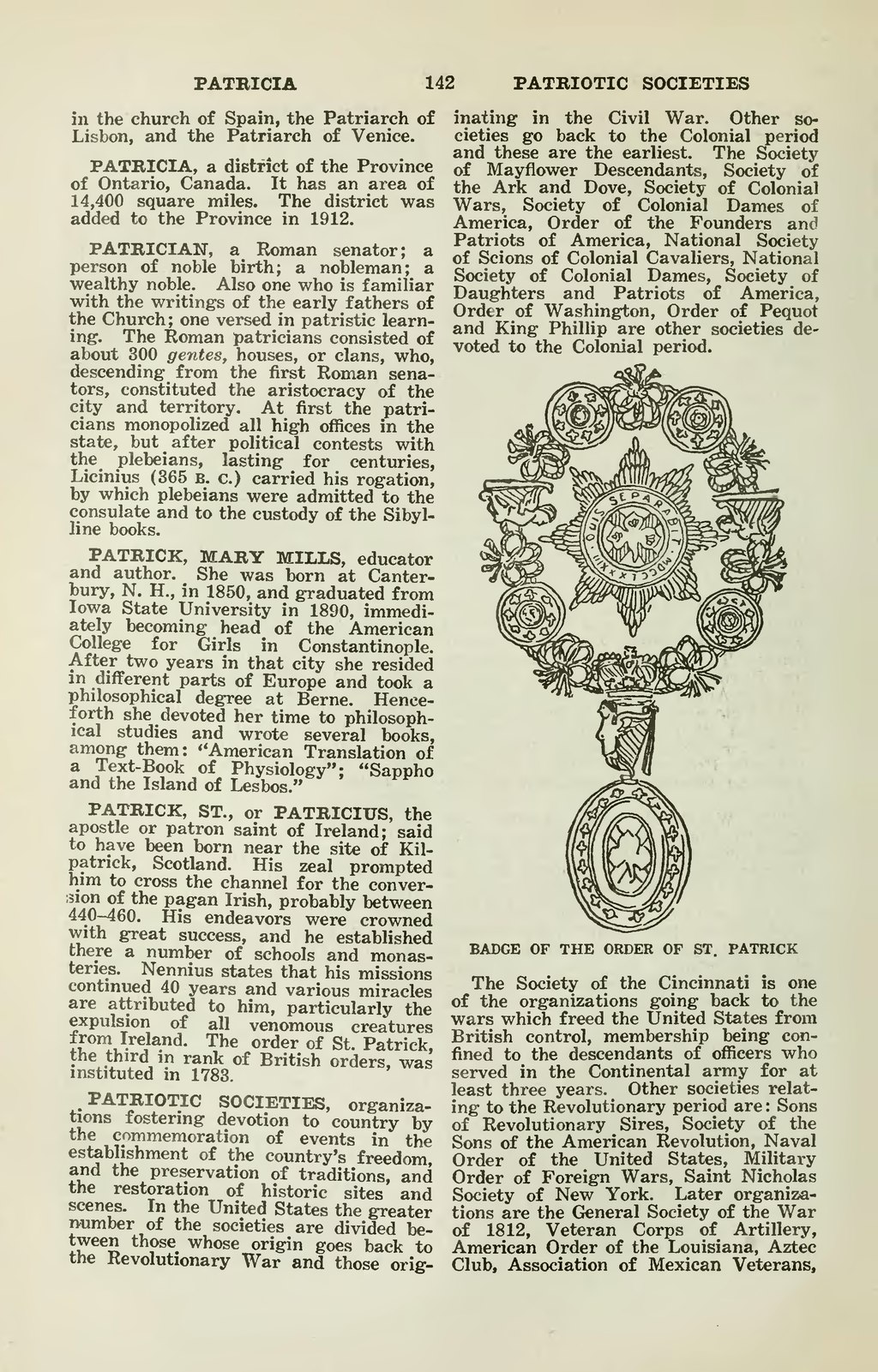PATBICIA 142 PATBIOTIC SOCIETIES in the church of Spain, the Patriarch of Lisbon, and the Patriarch of Venice. PATRICIA, a district of the Province of Ontario, Canada. It has an area of 14,400 square miles. The district was added to the Province in 1912. PATRICIAN, a Roman senator; a person of noble birth; a nobleman; a wealthy noble. Also one who is familiar with the writings of the early fathers of the Church; one versed in patristic learn- ing. The Roman patricians consisted of about 300 gentes, houses, or clans, who, descending from the first Roman sena- tors, constituted the aristocracy of the city and territory. At first the patri- cians monopolized all high offices in the state, but after political contests with the plebeians, lasting for centuries, Licinius (365 B. c.) carried his rogation, by which plebeians were admitted to the consulate and to the custody of the Sibyl- line books. PATRICK, MARY MILLS, educator and author. She was born at Canter- bury, N. H., in 1850, and graduated from Iowa State University in 1890, immedi- ately becoming head of the American College for Girls in Constantinople. After two years in that city she resided m different parts of Europe and took a philosophical degree at Berne. Hence- forth she devoted her time to philosoph- ical studies and wrote several books, among them: "American Translation of a Text-Book of Physiology"; "Sappho and the Island of Lesbos." PATRICK, ST., or PATRICIUS, the apostle or patron saint of Ireland; said to have been born near the site of Kil- patrick, Scotland. His zeal prompted him to cross the channel for the conver- sion of the pagan Irish, probably between 440-460. His endeavors were crowned with great success, and he established there a number of schools and monas- teries. Nennius states that his missions continued 40 years and various miracles are attributed to him, particularly the expulsion of all venomous creatures from Ireland. The order of St. Patrick, the third in rank of British orders, was instituted in 1783. PATRIOTIC SOCIETIES, organiza- tions fostering devotion to country by the commemoration of events in the establishment of the country's freedom and the preservation of traditions, and the restoration of historic sites and scenes. In the United States the greater number of the societies are divided be- tween those whose origin goes back to the Revolutionary War and those orig- inating in the Civil War. Other so- cieties go back to the Colonial period and these are the earliest. The Society of Mayflower Descendants, Society of the Ark and Dove, Society of Colonial Wars, Society of Colonial Dames of America, Order of the Founders and Patriots of America, National Society of Scions of Colonial Cavaliers, National Society of Colonial Dames, Society of Daughters and Patriots of America, Order of Washington, Order of Pequot and King Phillip are other societies de- voted to the Colonial period. BADGE OF THE ORDER OF ST. PATRICK The Society of the Cincinnati is one of the organizations going back to the wars which freed the United States from British control, membership being con- fined to the descendants of officers who served in the Continental army for at least three years. Other societies relat- ing to the Revolutionary period are : Sons of Revolutionary Sires, Society of the Sons of the American Revolution, Naval Order of the United States, Military Order of Foreign Wars, Saint Nicholas Society of New York. Later organiza- tions are the General Society of the War of 1812, Veteran Corps of Artillery, American Order of the Louisiana, Aztec Club, Association of Mexican Veterans,
Page:Collier's New Encyclopedia v. 07.djvu/186
This page needs to be proofread.
LEFT
142
RIGHT
